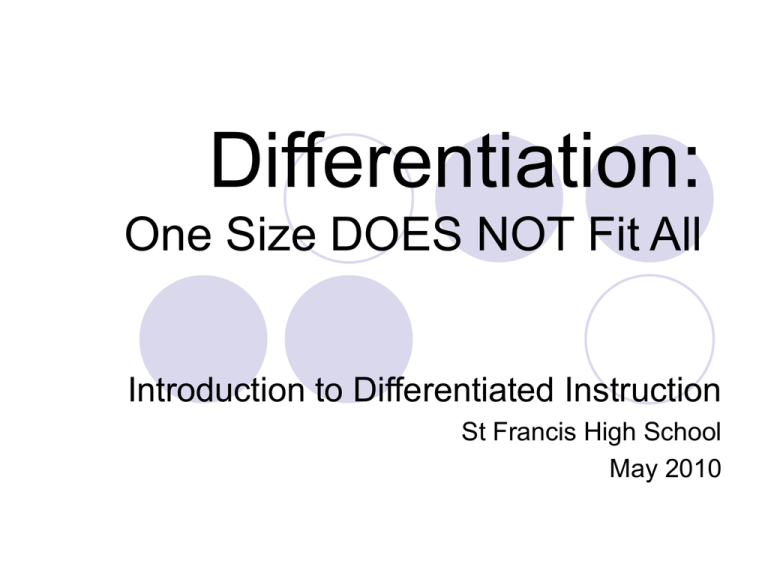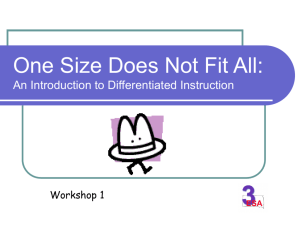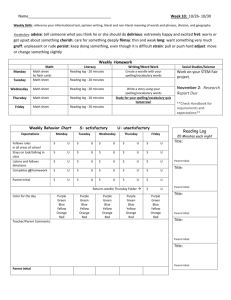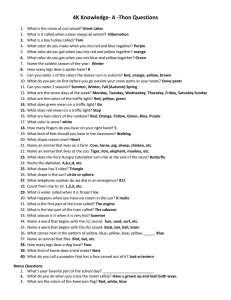Differentiation: One Size DOES NOT Fit All
advertisement

Differentiation: One Size DOES NOT Fit All Introduction to Differentiated Instruction St Francis High School May 2010 “If students don't learn the way we teach them, we must teach them the way they learn.” - Marcia Tate, Developing Minds Inc., Conyers, GA Outcomes Increased understanding of what differentiation IS and ISN’T Add strategies to our instructional toolbox Personalized License Plate Who Are Today’s Students? Silent Generation Born before 1946 Baby Boomers Born 1946-1959 Generation X Born 1960-1989 Generation Y Born since 1990 Essential Questions Who are the students in our classrooms? What “diversity” impacts and influences curriculum and instruction? Teams complete Star Diagram Differentiation IS NOT . . . The same as an IEP for every student Just another way to group kids Expecting less of struggling learners than of typical learners A substitute for specialized services Chaotic New Good Differentiation IS . . . Varied avenues to content, process, product Respectful of all learners Proactive Student-centered A blend of whole class, small group, and individual instruction Based on students’ readiness, interests, and/or learning profile Begin With the Brain Dots on Grids A B C D Give the Brain What It LOVES Processing Music Movement Humor Novelty Enrichment Connections Threat-free environment Pattern Feedback Simple Learning Styles Auditory Learns best from listening Visual Learns best from seeing Over 85% of Generation Y Kinesthetic/Tactile Learns best from doing Why Visual Literacy? Average 18 year old today 22,000 hours watching TV By age 14 has seen 12,000 murders on network TV programming!!!! 12,500 hours in school Average vocabulary of 14-year-olds is shrinking In 1950 – 25,000 words In 1999 – 10,000 words Visual Learner Images go directly to long-term memory in brain Humans process visuals 60,000 times faster than text Words processed sequentially Keyboard Images processed simultaneously Camera Vision & Learning “25% of students in grades k-6 have visual problems that are serious enough to impede learning.” (American Public Health Association) “It is estimated that 80% of children with a learning disability have an undiagnosed vision problem.” (Vision Council of America) 20/20 does not mean that vision is perfect! The 20/20 test does not test how well you see at reading distance. In fact, the 20/20 test fails to evaluate many other important aspects of normal vision such as: Eye focusing Eye coordination Eye teaming (binocular vision) Eye movement Visual perceptual skills Color vision TEACHER: Donald, what is the chemical formula for water? DONALD: H I J K L M N O. TEACHER: What are you talking about? DONALD: Yesterday you said it's H to O. Show ‘n Tell Teachers use graphic organizers Help learners visualize information Critical for visual learners!! Students use graphic organizers Great way for kinesthetic & visual students to process understanding Add another aspect Large size for group work Manipulate the pieces for the kinesthetic Graphic Organizer Examples Gardner’s Multiple Intelligences Logical/Mathematical Visual/Spatial Musical/Rhythmic Bodily/Kinesthetic Naturalist Interpersonal Intrapersonal Verbal/Linguistic It’s not “how smart you are” – it’s “how you are smart”! - Howard Gardner http://www.edutopia.org/multiple-intelligenceslearning-styles-quiz A Few Fun Strategies Involve ALL of the Senses . . . See Hear Taste Smell Touch Learning On Their Feet Movement stimulates the brain Use frequently at all ages levels Demonstration Participatory modeling Role-play Simulation Manipulatives Minds in Motion http://doe.sd.gov/oess/schoolhealth/mindsinmotion/ Smells Trigger Memory Smells stimulate memory – both positive & negative. Fresh air Peppermint Cinnamon Lemon Lavender (relaxing) Caution – check for smell sensitivity & allergies The Role of Music Stimulates the brain Activates thinking parts of the brain Creates a sound curtain to isolate groups Increases attentiveness Effects emotions, heart rate, mood, mental images of listener Embeds learning faster Alphabet song http://www.school-house-rock.com/Prea.html COLOR Increases Understanding Using color for key concepts can increase memory retention up to 25% Experiment Memorize the Pattern 30 seconds Orange Orange Red Red Yellow Yellow Purple Purple Pink Pink Orange Orange Yellow Yellow Blue Blue Black Black Red Red Blue Blue Green Green Memorize the Pattern 30 seconds Orange Orange Blue Green Green Purple Purple Purple Purple Yellow Pink Pink Red Red Red Red Orange Blue Blue Green Green Memorize the Colors Used 30 seconds Purple Purple Orange Orange Yellow Yellow Blue Blue Red Red Orange Orange Yellow Yellow Green Green Blue Blue Purple Purple Green Green Orange Orange Differentiation . . More Than One Way to Get There 3 Keys to Differentiated Instruction Content What we teach students Materials and methods used Process Activities Calls on students to use key skills Product How students show what they have learned Should also allow students to extend what they learned Key #1 – Adapt Content Refers to both materials & methods Accommodate students’ different starting points Some students ready for more complex or abstract levels Some students ready for independent work Content Differentiation Examples Multiple versions of texts Variety of texts to support concept Interest centers Learning contracts Support systems Audiotapes Mentors Study partners Key #2 – Adapt Process Common focus Vary student activities Students use key skills Bloom’s Taxonomy Multiple Intelligence Theories Teacher uses a variety of methods Process Differentiation Examples Tiered Assignments Layered Curriculum (Nunley) Learning Centers Jig Saw Assignments Learning Logs Graphic Organizers Modify their environment Fidgets Time flexibility Key #3 – Adapt Product Culminating learning experience that occurs after many days or weeks of study Demonstration and extension of what they know, understand, and are able to do Product Differentiation Examples Variety of assessment types Tiered Assignments Independent Study Enrichment vs remediation Variables to Consider Readiness – in reading, math, & beyond Complexity & Challenge of both process & product Pace of learning and production Grouping practices Use of assessment results to inform teaching and learning Guidelines for the Classroom Focus on essentials Attend to student differences NO strategy works on ALL students Assess often and use it to make adjustments/modifications Mutual respect DI is a proactive strategy Be flexible Doesn’t happen 100% of the time!!!! Building Blocks . . . Choice Encouraging higher level thinking Accountability Simple Ways to Start Add an interdisciplinary element to a favorite unit Collaborate with other teachers Provide choices Offer students a variety of process and/or presentation options Apply Multiple Intelligence thinking to group/individual projects Exit Card – 3 2 1 On an index card, please write 3 strategies from today you think you can do in your classroom next year 2 strategies from today that you are not comfortable with doing 1 strategy from today you will need help to implement you want more information for




